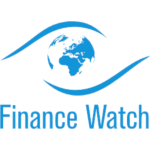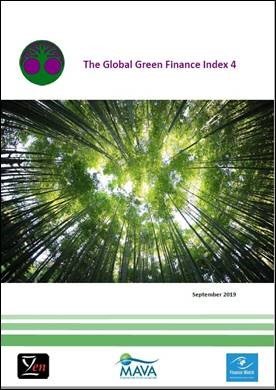Authors
Mike Wardle, Greg Ford, Benoît Lallemand, Professor Michael Mainelli & Simon Mills
Published by
Long Finance & Financial Centre Futures (September 2019), 101 pages.
Share on social media:




You might also be interested in:
The Global Green Finance Index 4 - Supplement "A Focus On Biodiversity"
The fourth edition of the Global Green Finance Index (GGFI 4) was published on 27 September 2019. GGFI 4 provides evaluations of the depth and quality of the green finance offerings of 64 major financial centres around the world. The GGFI serves as a valuable reference into the development of green finance for policy and investment decision-makers.
The GGFI has been developed jointly by Z/Yen, as part of its Long Finance Initiative, and Finance Watch. We are grateful to the MAVA Foundation for its sponsorship of this work.
The GGFI is updated and published every March and September. 114 financial centres were researched for GGFI 4 of which 64 now feature in the index. The GGFI is compiled using 132 instrumental factors. These quantitative measures are provided by third parties including the World Bank, the Economist Intelligence Unit, the OECD and the United Nations.
The instrumental factors are combined with financial centre assessments provided by respondents to the GGFI online questionnaire. GGFI 4 uses 4,220 assessments from 735 respondents.
The Results Of GGFI 4 Include:
- Ratings of green finance rose in almost all centres for both depth and quality. With one exception, all centres received a higher rating for quality than in GGFI 3. Average performance across the measures of green finance depth and quality increased, with the average rating rising 2.2% for depth and 3.8% for quality compared with GGFI 3.
- Several centres moved more than five places in the indices. Munich is up nine places in the depth index, with San Francisco and Rome also improving more than five places. Calgary, Liechtenstein and Kuala Lumpur rose more than five places for quality.
Leading Centres
- Western Europe continues to lead the world’s centres in green finance depth and quality, taking eight of the top ten places in depth and all ten of the top ten places in quality.
- Amsterdam retained its leading position in the depth index, with Luxembourg regaining the ground it lost in GGFI 3 to take second place.
- London retained its position as first in the quality index, albeit with a smaller margin than before, with Amsterdam overtaking Paris to rank second. On current trends, London would lose its top ranking for quality within the next 12 months. Brussels displaces Geneva to move into the top 10.
- Narrow margins continue to separate centres at top of the tables. Among the top ten centres the spread of ratings is 47 out of 1,000 for depth (37 in GGFI 3) and 53 for quality (60 in GGFI 3).
Other News
- The Asia/Pacific region has fallen back slightly in this edition.
- Several centres moved more than five places in the indices. Munich is up nine places in the depth index, with San Francisco and Rome also improving more than five places. Calgary, Liechtenstein and Kuala Lumpur rose more than five places for quality.
Leading Centres
- On depth, the top 10 centres all stayed in the top group, with some minor adjustments in placing. Hamburg continued to progress, moving up three places in the rankings to equal 7th with Paris. Zürich fell three places to 5th following a sharp rise in GGFI 3.
- On quality, Brussels displaces Geneva to move into the top 10. London’s lead in the quality index has reduced from 52 in GGFI 1 to 18 in GGFI 4.
- Narrow margins continue to separate centres at top of the tables. Among the top ten centres the spread of ratings is 47 out of 1,000 for depth (37 in GGFI 3) and 53 for quality (60 in GGFI 3).
Western Europe
- Western Europe continues to improve its ratings across depth and quality, with all but one centre receiving improved ratings for both depth and quality.
- Munich rose nine places to 11th in the depth index, while Rome improved six places to 31st.
- Liechtenstein gained eight places in the quality index.
- Milan, Dublin, and Guernsey fell in the rankings for both depth and quality.
North America
- San Francisco was again the leading centre for quality in North America, retaining its 11th place in the index. It also increased its ranking by seven places to 17th in the depth index. Montréal again took first place in the region for depth, at ninth position overall and rose five places to 13th overall for quality.
- Calgary and Chicago both improved their position in the rankings for both depth and quality.
- Canadian centres continue to outperform the USA both in depth and quality.
Asia/Pacific
- Asia/Pacific centres overall fell back in the rankings for both depth and quality, even though ratings improved slightly overall, meaning that other centres improved their performance at a faster rate.
- Shanghai retained its leading position in the region for depth, with Guangzhou improving five places in the depth rankings to 17th overall.
- Melbourne and Sydney lead the region for quality.
Middle East & Africa
- Casablanca consolidated its reputation as the regional leader, retaining its 13th place in the overall rankings for depth and placing 17th in quality.
- New entrant Tel Aviv took second place in the region and ranked 30th for depth and 25th for quality.
- Other centres in the region generally lost ground in the rankings, although ratings generally improved.
Latin America & The Caribbean
- São Paulo retained its leading position in the region and rose three places in the rankings for quality. Further analysis of the city’s approach is contained in the GGFI São Paulo case study published in May 2019. Cayman Islands rose to second place in the region for depth.
- The British Virgin Islands and Mexico City fell in the rankings for both depth and quality.
Eastern Europe & Central Asia
- Prague consolidated its position as the regional leader and retained its ranking at 22nd overall for quality.
- Warsaw fell in both the depth and quality rankings; and Istanbul and Moscow both improved their position in the depth rankings.




